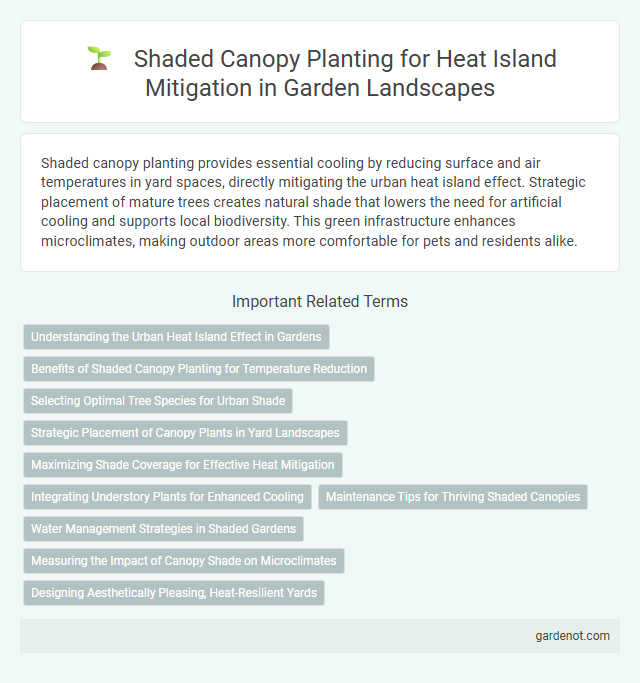Shaded canopy planting provides essential cooling by reducing surface and air temperatures in yard spaces, directly mitigating the urban heat island effect. Strategic placement of mature trees creates natural shade that lowers the need for artificial cooling and supports local biodiversity. This green infrastructure enhances microclimates, making outdoor areas more comfortable for pets and residents alike.
Understanding the Urban Heat Island Effect in Gardens
Shaded canopy planting plays a crucial role in mitigating the urban heat island effect by reducing surface temperatures through increased vegetation cover and evapotranspiration. Trees and large shrubs create shade that lowers ground and ambient air temperatures in urban gardens, contributing to cooler microclimates. Incorporating native and drought-resistant canopy species enhances resilience while maximizing thermal comfort and energy savings in urban heat island-prone areas.
Benefits of Shaded Canopy Planting for Temperature Reduction
Shaded canopy planting significantly reduces surface and air temperatures by providing a natural barrier against solar radiation, lowering heat absorption on pavements and buildings. This cooling effect helps mitigate urban heat island intensity, improving local microclimates and reducing energy demand for air conditioning. Enhanced shade from mature trees also promotes evapotranspiration, further contributing to temperature regulation and increased thermal comfort in outdoor spaces.
Selecting Optimal Tree Species for Urban Shade
Selecting optimal tree species for urban shade involves prioritizing heat-tolerant, fast-growing trees with broad canopies to maximize cooling effects and improve air quality. Species such as Quercus (oak), Platanus (plane tree), and Acer (maple) are ideal due to their high transpiration rates and dense foliage that provide extensive shade coverage. Incorporating native and drought-resistant trees ensures sustainability, reduces maintenance costs, and enhances biodiversity in heat island mitigation yards.
Strategic Placement of Canopy Plants in Yard Landscapes
Strategically placing canopy plants in yard landscapes maximizes shade coverage, significantly reducing surface temperatures and mitigating urban heat islands. Selecting species with broad, dense canopies near patios, walkways, and structures optimizes cooling effects by blocking direct sunlight and enhancing evapotranspiration. Integrating native, drought-tolerant trees further conserves water resources while sustaining long-term yard climate resilience.
Maximizing Shade Coverage for Effective Heat Mitigation
Shaded canopy planting plays a crucial role in maximizing shade coverage to effectively mitigate urban heat islands by reducing surface and air temperatures. Selecting fast-growing, broad-leaved tree species with dense canopies enhances cooling effects through increased evapotranspiration and shading of paved surfaces. Strategic placement of these trees in high-exposure areas like parking lots and sidewalks significantly lowers ambient temperatures, improving thermal comfort and reducing energy consumption.
Integrating Understory Plants for Enhanced Cooling
Integrating understory plants beneath shaded canopies significantly enhances cooling effects by increasing transpiration and providing multi-layered vegetation coverage that reduces ground surface temperatures. These understory species contribute to improved soil moisture retention and air circulation, which collectively mitigate urban heat island intensity. Strategic selection of drought-tolerant, native understory vegetation maximizes ecological benefits while supporting microclimate regulation in heat island mitigation yards.
Maintenance Tips for Thriving Shaded Canopies
Regular pruning and watering are essential for maintaining healthy shaded canopies in heat island mitigation yards, promoting optimal growth and shade density. Applying mulch around the base conserves soil moisture and regulates temperature, supporting root health during hot periods. Inspecting for pests and diseases early prevents damage and ensures long-term canopy vitality in urban environments.
Water Management Strategies in Shaded Gardens
Shaded canopy planting in heat island mitigation yards significantly enhances water management by reducing soil evaporation and promoting efficient water retention. Deep-rooted trees under shaded canopies improve groundwater recharge while their leaf litter enriches soil organic matter, enhancing moisture-holding capacity. Strategic placement of shade trees around rain gardens and bioswales optimizes stormwater infiltration, minimizing runoff and supporting sustainable urban water cycles.
Measuring the Impact of Canopy Shade on Microclimates
Shaded canopy planting significantly reduces urban heat island effects by lowering surface temperatures and improving microclimate conditions. Measuring the impact involves precise monitoring of temperature variations beneath tree canopies, humidity levels, and solar radiation intensity to quantify cooling benefits. Data-driven analysis highlights that strategic canopy placement enhances thermal comfort and decreases energy consumption in heat island mitigation yards.
Designing Aesthetically Pleasing, Heat-Resilient Yards
Shaded canopy planting in heat island mitigation yards enhances cooling by strategically positioning large, heat-tolerant trees to block direct sunlight and reduce surface temperatures. Selecting species such as oak, maple, or native drought-resistant trees ensures durability in high-heat environments while contributing to visual appeal and biodiversity. Integrating layered vegetation and thoughtful spacing optimizes shade coverage and airflow, creating aesthetically pleasing, comfortable outdoor spaces that effectively combat urban heat.
Shaded canopy planting Infographic

 gardenot.com
gardenot.com